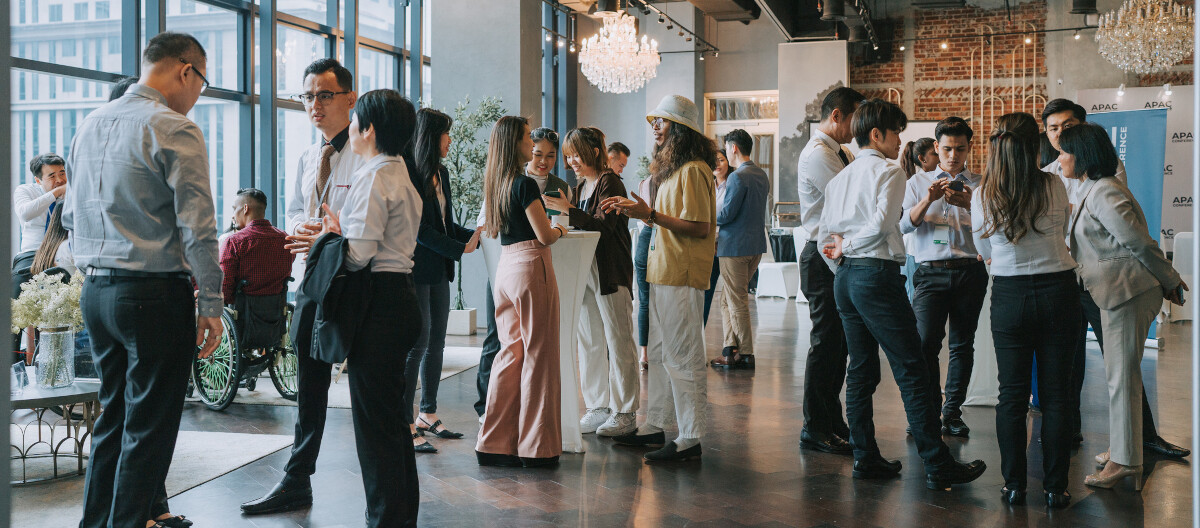Proper conduct at B2B trade fairs
Face-to-face trade fairs are and will remain an important sales channel in the B2B sector and a major factor for lead generation – despite the abundance of digital and virtual events. To make the most of face-to-face interactions, you need to be well prepared. How you go about this depends primarily on the industry and target group. For example, at some events more traditional behaviour is expected, while others have a distinctly relaxed atmosphere. Either way, there are a number of specific practices which are appropriate for trade fairs of all kinds, both for visitors and for stand staff. This applies not only to your appearance and behaviour during the show itself, but also to any follow-up. These recommendations will help you make the most of a B2B event.
Preparation: for visitors and organisers
Every visit to the trade fair should begin before you enter the exhibition area. Preparation is different for trade fair visitors and for stand staff.
Planning a trade fair visit
As a visitor, it’s advisable to arrange a series of stand appointments and background discussions during the planning phase of your visit to the trade fair. This means preparing for the discussion and working out what topics and specific questions you want to cover. It can be helpful to seek advice and suggestions from colleagues. Another important point is the mode of travel – by train, car or plane. Remember to book tickets in advance if necessary. This also applies to booking hotel rooms for longer stays, as the prices can otherwise be exorbitant. And, of course, remember to pack appropriate attire, both for official meetings and, if necessary, for more relaxed social events.
For exhibitors: planning your trade fair presence
As with planning a visit to a trade fair, exhibitors are primarily concerned with finding the right event, but also the right type of presentation. This means it’s important to weigh up whether your involvement is meaningful and worthwhile. Also consider the main purpose of your presence: brand-building, customer acquisition or presenting a new product?
Your presence and its branding should be based on this and the needs of the target group. In addition to the equipment and the associated costs, you also need to consider whether you have enough appropriately-trained staff for the stand. Make sure to address any technical issues on site (such as electricity, water, telephone and internet connections). You should also announce your participation in advance – via brochures, the company website or a designated landing page, as well as via email and various social media channels. Ensure that you mention the programme (including schedules) in your publicity for trade fair visitors, as well as other useful information such as parking and nearby restaurants. It’s also advisable to personally invite important contacts and prospective customers.
Present your company on our platform!
The advantages:
- International audience and visibility
- Set-up in 5 minutes
- Numerous options and services through individual content
Trade fair etiquette: the most important rules
Politeness and professional behaviour can give both trade fair visitors and exhibitors an advantage. Both sides should approach each other with respect and openness. Keep your agreed appointments and where necessary, prepare individually for them. In conversation, you should ask relevant questions, and give any suggestions or possible criticism in a businesslike manner - this includes always letting the other person finish what they are saying. Don’t make promises you can’t keep.
All participants should remain alert, attentive and focused for the entire duration of the fair, as well as during the more informal evening programme. Evening events often offer unexpected opportunities for networking. However, don’t take it too far: showing up tired or hungover for an appointment the next day will not make a good impression. Stand staff must not congregate in groups or look bored. Hands in trouser pockets and sitting for long periods of time are a no-no, as is a brash, “hard-sell” approach.
Top tips for closing deals and finding new business partners
To make a B2B trade fair a success, you need the right people in the right jobs. This applies to both visitors and exhibitors. In both cases, specific responsibilities and tasks should be allocated, so that everyone involved knows what are doing. Regardless of how a contact is made and what the goal is, the exchange must always be respectful and on equal terms. You also need to determine how long discussions and negotiations with each business partner should take. Factor in buffers in case an important appointment overruns and make sure that the time allocated is proportionate to your desired outcome.
Both sides should have important information, such as customer or product information, to hand. This should be produced in a format that is easily transferable digitally. It won’t hurt to have your business card to hand, including your contact details.
After the fair: follow-up
Follow-up is at least as important as the trade fair itself, since this is the only way that many encounters turn into leads or even progress to deals. Make sure to allow sufficient time for this after the exhibition. Important points to remember: Evaluate the lead information you’ve collected (digitally) and sort it according to potential opportunities. Don’t forget to do the same with business cards. Prioritise particularly promising contacts in order of importance and get in touch directly after the fair. Provide all these contacts, and all other serious interested parties, with suitable offers, forms or brochures. If possible, do this within two weeks of the end of the fair.
The more concrete your goals for the event, the easier it is to use them as the ultimate yardstick for success, so it’s a good idea to have a debrief with all relevant stakeholders. Which targets were achieved and which were not? What went well and where is there room for improvement? These and similar questions should be discussed internally about four weeks after the fair. This means you can also make decisions about the content, design and operational details of the next event.

